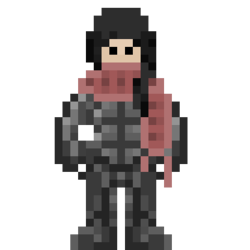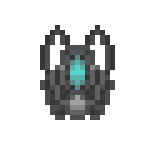Offworlder Humans
▶ This wiki page is currently behind the Phoron Scarcity update ◀
Information concerning phoron or the phoron scarcity may be outdated, lacking or unsatisfactory. Questions related to the phoron rework can be raised on Lore Discord.
| Offworlder Humans |
| H. sapiens / Human |
 |
| Home System: N/A |
| Homeworld: N/A |
| Language(s): Tau Ceti Basic/Freespeak |
| Political Entitie(s): Scarabs |
Referred to most commonly as offworlders, these humans negatively affected by low gravity are a common sight in remote regions of the Orion Spur colonized by humanity. The largest known concentration of offworlders is the Scarab Fleet, a nomadic group which wanders throughout the Coalition of Colonies and “wild” frontier. Offworlders have, through generations of living in space, been physically changed by their circumstances. They are well-known for their elongated, unnaturally, and atrophied appearances and some offworlders have grown to be as tall as seven and a half feet (226cm). As a result most require some form of bracing and life support to sustain themselves for prolonged times in standard atmosphere and gravity, though have no issue surviving in either for hours at a time. Augments, prosthetics, and genetic modification have all been utilized by offworlders to overcome their physical limitations, with those from more wealthy backgrounds – such as the small but notable population on Valkyrie – having easier access to these techniques than Coalition or frontier offworlders.
Offworlders have long been employed on corporate facilities throughout the Orion Spur but, thanks to the recent proliferation of the Coalition-originated Exo-Stellar Skeleton (ESS), offworlders are now finding employment in many facilities where gravity would have previously prevented them from working. Regenerative Muscular Therapy, or RMT, supplements which encourage a reversal in the muscular atrophy common amongst offworlders are used for a similar purpose. While neither an ESS nor RMT are mandatory for an offworlder to survive, they are highly sought-after by many offworlders due to the comfort they bring to life.
Mechanics
Low-gravity Humans mechanically: Have much weaker bones, meaning their bones break easily. Have much weaker organs, meaning their organs take higher damage. Are much more susceptible to toxins. Are much more resistant to light sources such as flashes Are much more resistant to low pressure and have a much higher threshold for lung damage. Only require the bare minimum air to reliably breathe - somewhere around 15kpa ingame. (Not currently implemented)
- Require assistance to stand upright comfortably through various means listed below. If offworlders attempt to stand without assistance, they receive massive discomfort and physical slowdown.
- Bleed much more slowly than normal Humans.
RMT Pill Supplements
RMT (Regenerative Musculature Tissue) pill supplements are used by those seeking to remedy the effects of prolonged zero-G adaptations. Mechanically, these work by nullifying the discomfort message and slowdown. You spawn with these automatically as an Offworlder. They have no other effects but can overdose at forty units, causing muscle pains.
Prosthesis
Any form of prosthesis which encompasses both legs removes the slowdown and discomfort entirely.
The ESS

The Exo-Stellar Skeleton, or ESS for short, is the offworlder’s most unique asset. Utilized in much the same way as a standard hardsuit, it deploys into a tightly-fitting chest and headpiece. The headpiece operates like a normal helmet and mask while the chestpiece serves no purpose other than to hold specialized accessories. Neither are space-proof. These are equipped with very little universally, generally things to maintain and keep the offworlder alive and well during their time in the hostile environments other humans call home.
The ESS is equipped with:
- An emergency injection system that, once the user exceeds a certain damage threshold, injects 5 units of dexalin and 5 units of Inaprovaline into the user’s bloodstream.
- An integrated vitals tracker that allows the player to scan their own body’s vitals and nobody else.
The ESS has no statistics of its own and possesses no armor. Unlike true harduits the ESS does not splint broken bones. The helmet offers welding protection and the ESS can only equip two hardsuit modules alongside its default equipment, which cannot be removed. The following modules cannot be utilized: Any weapon, including grenade launchers. Combat chem injectors.
Operating the ESS may seem overwhelming at first, but it's actually pretty simple. Once you spawn in as an offworlder, if the ESS is already on your back, you can toggle it on by using the "Toggle Hardsuit" verb found under Hardsuit Menu at the top right. If there are errors, such as overwear or a hat in the way, it will alert you in the chat. To remedy this, simply remove them. Once the RIG itself deploys, the visor should turn a bright transparent blue to indicate it is active. Do not move during the activation process, as it will restart it!
Once completely active, you can press "Toggle Chestpiece" or "Toggle Helmet" in the same tab to retract or deploy either freely, so you can place your hat/overwear back on.
In the Hardsuit Modules tab, you can access any installed modules on the ESS or activate the personal scanner using the buttons there. These can be activated from the Hardsuit Menu as well, by pressing the "Hardsuit Interface" verb.
Biology
Biologically, offworlders are humans who have had various bodily functions affected by low-gravity. These effects vary from offworlder to offworlder, and generally become more extreme the longer one’s ancestors have spent in low-gravity environments. Scarabs are known to suffer some of the most extreme biological divergences of any offworlders. A universal trait of offworlder physiology is the muscle atrophy resulting from their low-gravity environments. Offworlder communities such as the Scarabs have long counteracted this atrophy through exercise and physical activity as sufficient physical inactivity can cause an offworlder’s musculature to atrophy to a point where movement in any gravity becomes a challenge. Regaining lost muscle mass is often difficult for offworlder, as is gaining weight more generally. This has resulted in most offworlders possessing a lanky build which often looks atypical when combined with their height.
Society and Culture
Offworlders are known for residing in very closely-knit communities which place a heavy emphasis on mutual cooperation and social connections. Many offworlders struggle with adapting to non-offworlder societies due to this form of hyper-socialization and often fall into a state of depression or loneliness as a result, even when surrounded by others. Oral tradition is very important in most offworlder societies due to the importance of passing knowledge concerning space travel from generation to generation and the often lack of formal education systems in more remote offworlder communities. An emphasis is placed upon EVA training as it is where many offworlders spend the majority of their time.
In an environment as hostile as space, the daily routes of many offworlders consist of little aside from work, exercise and rest, with any relaxation time being a communal activity. Due to the need to conserve resources in space many offworlders possess a conservationist lifestyle which places a great emphasis upon practicality over luxury.
Though most Offworlders are similar, three varieties commonly occur across space.
Spacers are perhaps the most ubiquitous, dwelling primarily in orbital stations or any sort of interstellar vessel. Their highly varied upbringings permit a vast selection of character backgrounds, but most Spacers can trace their origin to the Coalition of Colonies and few can be found in more populated regions of the Spur such as the Solarian Alliance or Republic of Biesel though some exceptions, such as Valkyrie in Tau Ceti, exist. The most well-known spacers are the members of the Scarab Fleet, the largest known group of offworlders in the Orion Spur.
Drifters are offworlders which reside on low-gravity planets or asteroids, and are often seen herding hahkma or other insectoid fauna. Many of these offworlders are commonly landowners whose ownership of their claim has been passed down through generations. These offworlders are often found within the free frontier, where the control of the Solarian Alliance faded after the Interstellar War, and often reside in decaying facilities suffering from centuries of limited contact with the broader Spur. The Empire of Dominia’s colonial campaigns occasionally displace populations of these offworlders as they conquer nearby systems, which has led to many becoming refugees in the Republic of Biesel or Non-Citizen Persons in the Republic of Elyra.
The smallest, and most unusual, major offworlder population are the so-called Star Men, who have embraced heavy augmentation in order to survive in harsh environments such as Burzsia. Many of these Star Men have their own styles of augmentation unique to their particular system, or facility, which allow them to survive even the harshest of environments. Star Men are often sought after by megacorporations such as Hephaestus Industries for employment due to their familiarity with harsh environments and reliance on augmentation, which often places them into debt with their employer.
History
Offworlders are seen by many as the result of comparatively primitive space travel before the advent of practical artificial gravity in the early 2200s. Artificial gravity’s widespread adaptation in the modern Coalition was delayed by the Interstellar War and its aftermath, and many modern anthropologists note this is the reason for the Coalition’s comparatively large offworlder population compared to other nations of the modern Spur. Modern offworlders are typically descended from the original inhabitants of these low-to-no-gravity vessels and are, as a result, a minority compared to baseline humans as one must dwell within low-gravity for multiple generations for true “offworlder traits” to begin appearing.







